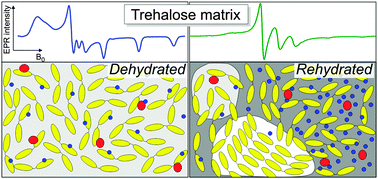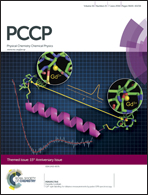Structural and dynamical characteristics of trehalose and sucrose matrices at different hydration levels as probed by FTIR and high-field EPR
Abstract
Some organisms can survive complete dehydration and high temperatures by adopting an anhydrobiotic state in which the intracellular medium contains large amounts of disaccharides, particularly trehalose and sucrose. Trehalose is most effective also in protecting isolated in vitro biostructures. In an attempt to clarify the molecular mechanisms of disaccharide bioprotection, we compared the structure and dynamics of sucrose and trehalose matrices at different hydration levels by means of high-field W-band EPR and FTIR spectroscopy. The hydration state of the samples was characterized by FTIR spectroscopy and the structural organization was probed by EPR using a nitroxide radical dissolved in the respective matrices. Analysis of the EPR spectra showed that the structure and dynamics of the dehydrated matrices as well as their evolution upon re-hydration differ substantially between trehalose and sucrose. The dehydrated trehalose matrix is homogeneous in terms of distribution of the residual water and spin-probe molecules. In contrast, dehydrated sucrose forms a heterogeneous matrix. It is comprised of sucrose polycrystalline clusters and several bulk water domains. The amorphous form was found only in 30% (volume) of the sucrose matrix. Re-hydration leads to a structural homogenization of the sucrose matrix, whilst in the trehalose matrix several domains develop differing in the local water/radical content and radical mobility. The molecular model of the matrices provides an explanation for the different protein–matrix dynamical coupling observed in dried ternary sucrose and trehalose matrices, and accounts for the superior efficacy of trehalose as a bioprotectant. Furthermore, for bacterial photosynthetic reaction centers it is shown that at low water content the protein–matrix coupling is modulated by the sugar/protein molar ratio in sucrose matrices only. This effect is suggested to be related to the preference for sucrose, rather than trehalose, as a bioprotective disaccharide in some anhydrobiotic organisms.

- This article is part of the themed collection: PCCP’s 15th anniversary

 Please wait while we load your content...
Please wait while we load your content...